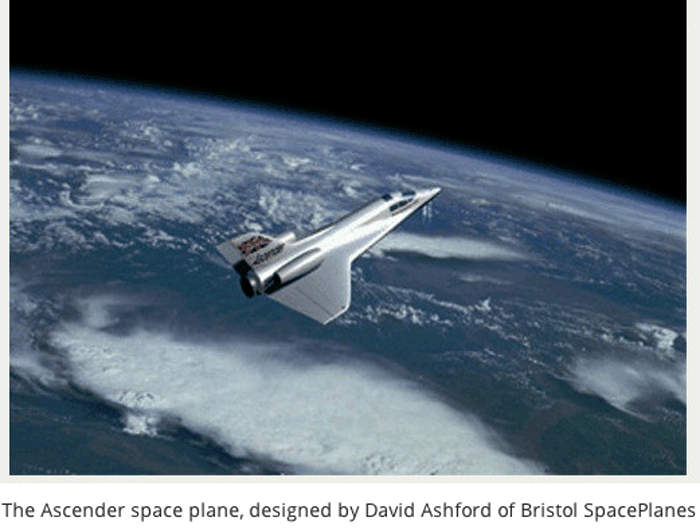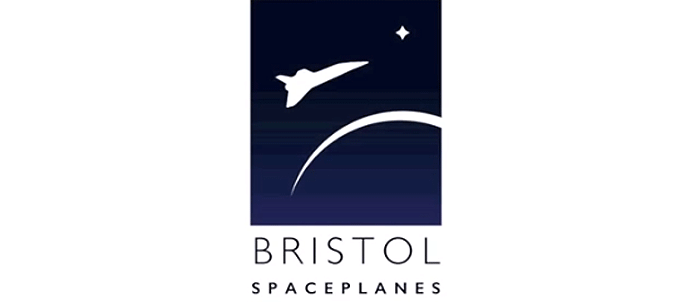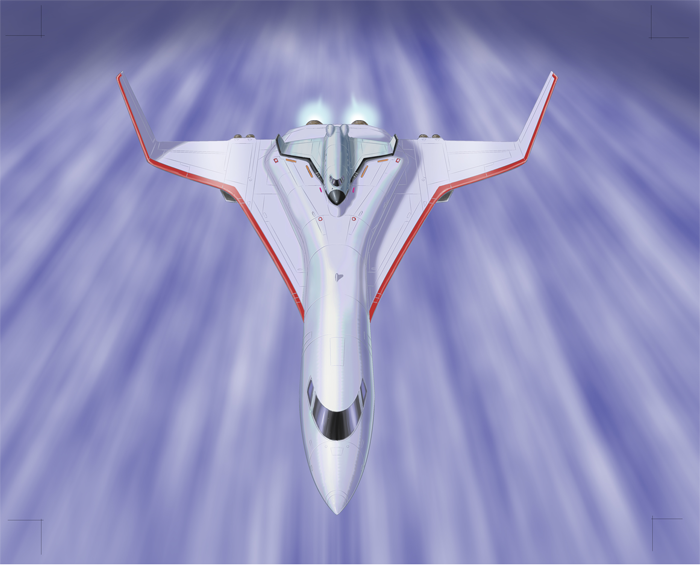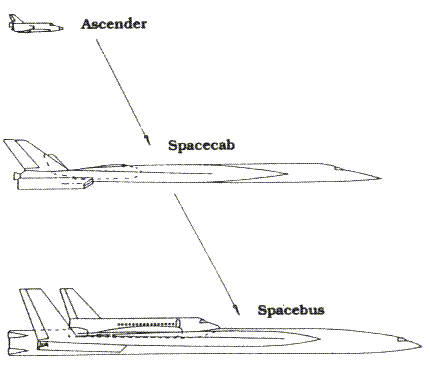.

Bristolians are being invited to help launch planes into space in a new crowd-funding campaign.
Bristol SpacePlanes, a local firm which hopes to one day make space travel affordable, wants to raise £10,000 to build the first model of its Ascender space plane.




Founder David Ashford believes organisations such as NASA having being going about space travel the wrong way and that it could become much cheaper by reviving some old ideas from the 1960s.
“The main barrier is not the technology, but changing people’s mindset” he said. “The technology is proven it’s just a case of getting people to believe.
“Support us and you will, we truly believe, be helping us to bring spaceflight to the masses within 15 years.”
One the reasons space flight is so expensive, costing millions of pounds to send an astronaut into space, is that rockets burn out and can’t be re-used.
“Imagine how much motoring would cost if we threw away the car after every journey,” said David.
“It is clear that an airliner that could fly to orbit would transform this situation. It could provide an airline service to orbit and open up large new markets, especially tourist visits to space hotels.
“What is less well known is that in the 1960s most big aircraft companies in Europe and the USA studied space planes in depth. There was a consensus that space planes were the obvious next step and that they were just about feasible with the technology of the day.”
David was involved in that work in the 1960s, but said the focus on the Cold War between East and Western Europe meant the ideas were never developed further.
He founded Bristol SpacePlanes in 1991 and has designed a reusable sub-orbital spaceplane.
The Ascender, if ever built, would be the first step carrying a pilot and one passenger. It would be used to generate money to develop the following phases and pave to way to eventually building the SpaceBus which would carry up to 50 passengers into space.
The Crowdfunder campaign will run for six weeks and can be found here.
FACTFILE
The Ascender
Ascender carries one pilot and one passenger or experiment.
The passenger remains strapped in his/her seat during the flight.
Ascender takes off from an ordinary airfield using its turbo-fan engine and climbs at subsonic speed to a height of 8km (4.9 miles).
The pilot then starts the rocket engine and pulls up into a steep climb. Ascender has a maximum speed of around Mach 3 (761 mph) on a steep climb and can reach a height of 100 km (62 miles).
It has a wing span of 7.6 metres and length of 12.9 metres
The plane would be powered by two jet engines and two rocket engines, fuelled by HTP and kerosene.
--

Affordable space travel is possible, and you can help make it a reality.
We’re on the verge of a new space age and we want you to be part of it.
At Bristol Spaceplanes, we are proposing a straightforward way of slashing the cost of access to space. This would lead to most of us being able to afford a visit to a space hotel. This is clearly a major undertaking, so we are looking for industrial partners to help make it happen. Incredibly, the main obstacle is not technology or finance but the power of traditional thinking.
We therefore propose a step-by-step programme starting with projects aimed at denting the mindset while being affordable to you crowdfunders.
By supporting this project YOU can make a fundamental contribution to the revolution in spaceflight!
Slashing the cost of space travel with an orbital spaceplane
There is a fairly obvious way of slashing the cost of space travel, which is to develop an airliner that can fly to and from orbit—an orbital spaceplane. This would replace today's throwaway launchers based on ballistic missile technology and provide an airline service to space.
It would lead to nothing less than a new space age.
.

This isn't a new idea, we knew how to build spaceplanes in the 1960s! At the time, most big aircraft companies (three in the UK alone) studied spaceplanes in some depth. It was in the early days of spaceflight when it seemed clear enough that using converted ballistic missiles for launching satellites could never be economical, because they could fly once only. There was a wide consensus that spaceplanes were the obvious next step and that they were feasible with the technology of the time. There was also a consensus on some of the key design features.
These designs were not built at the time because of the priority given to the Cold War space race, and the teams were allowed to disband. Then the Space Shuttle was built much more like a missile than an aeroplane, even though early designs were true spaceplanes. This history has created institutions and habits of thought that have repeatedly reinforced the throwaway habit.
Most of these 1960s designs would have been far better than anything built since, or even proposed by a major company. Only we are proposing spaceplanes on these lines, probably because the founder, David Ashford, is one of the very few involved in the 1960s round of studies who is still active in the field. Spaceplanes seemed like a good idea at the time, and they still do! What would then have been a feasible but difficult project would now be straightforward—all the required technologies have been proven in flight on other vehicles.
At present, the space establishment hardly 'wants to know' about spaceplanes, and the large agencies are supporting new throwaway launchers.
Our approach
Given that mindset is the main obstacle, we are proposing a five-phase approach to development, starting with a project small enough for you crowdfunders to pay for. Each vehicle is aimed at gaining the credibility needed for the next one on the sequence.
A radio-controlled flying model.
A very small piloted demonstrator called Microsonic.
A small entry-level suborbital spaceplane called Ascender. This is loosely based on the Saunders Roe SR.53 rocket fighter that first flew in 1957! (At the time, Saunders Roe proposed converting the prototypes for space research. This project would have been straightforward to build, but it never happened.)
A small orbital spaceplane called Spacecab. This is our key project, as it would be the first to provide airline service to orbit. Spacecab, combines 1960s ideas with up to date (but not new) technology. It is designed to meet the key requirements for the first orbital spaceplane—greatly improved safety and rapid development.
Spacebus, which is an enlarged development of Spacecab
In brief, we are proposing a rapid catch-up with what might have been.
The aim of the model and demonstrator is to overcome the prevailing mindset. Thereafter the investment will come from commercial sponsorship or industrial partners, as later vehicles can earn their keep from commercial operations and have a very good business case.
Once this programme gets started, it is so attractive that it is very likely to carry on. And YOU can help fund the first step!
Why crowdfunding?
We have been very busy over the last 20 years designing and perfecting the design of Spacecab and now it’s time to get it off-paper by getting a model built. Whilst this may not sound like much, the most difficult step in any journey is the first one!
This model will not only help us to further improve our designs but it will also help us to attract industrial partners. These partners are our next step towards affordable space tourism and this model will transform us from think tank to an operations company.
Be part of something truly exciting and join us in telling the world that space tourism is closer than they think for the likes of us ordinary folk! Support us and you will, we truly believe, be helping us to bring space flight to the masses within 15 years.
Yes, you read that right—15 years. Journey to a space hotel for not much more than a return first class ticket to New York.
We hope that you’re excited. By supporting us you can help overcome the main obstacle to the New Space Age—mindset.
The Ascender Spaceplane
.

Ascender is a small sub-orbital spaceplane designed to use existing technology and to pave the way for later vehicles on our development sequence.
Ascender carries one pilot and one passenger or experiment. The passenger remains strapped in his/her seat during the flight. It takes off from an ordinary airfield using its turbo-fan engine and climbs at subsonic speed to a height of 8 km. The pilot then starts the rocket engine and pulls up into a steep climb. The maximum speed is of the Ascender is around Mach 3 on a steep climb and it can reach a height of 100 km.
At that time, the passenger will see superb views of Earth and will see the sky turn black even in daytime. Then Ascender enters a steep dive, where a passenger can experience two minutes of weightlessness. On reaching the atmosphere, the pilot pulls out of the dive and flies back to the airfield from which they took off 30 minutes previously.
Successors
Ascender has been designed to pave the way for later vehicles on our development sequence.
Ascender’s successor, Spacecab, would be a fully orbital spaceplane and use existing engines and proven materials. With the benefits of full reusability, its cost per flight will be well over 100 times less than that of the Shuttle.
An enlarged development of Spacecab, called Spacebus, is designed to carry 50 people to and from orbit. A second-generation Spacebus would also be capable of carrying passengers from Europe to Australia in some 75 minutes flying time.
.

About Bristol Spaceplanes
Bristol Spaceplanes was formed in 1991 by David Ashford to realise low-cost access to space by exploiting the decades of spaceplane design experience of its founder. We have had study contracts or grants from four government agencies, and have started to bench-test the rocket engine.You can find more detail on our website and in the founder's recent book 'Space Exploration' (Hodder, 2013).
We’ve built up a team of the industry’s best and brightest experts to ensure that we are at the very top of our game. Here are the key members of our team:
David Ashford
The founder and Managing Director of Bristol Spaceplanes is David Ashford. He graduated from Imperial College, London, in aeronautical engineering and spent one year at Princeton doing post-graduate research on rocket motors. His first job, starting in 1961, was with the Hawker Siddeley Aviation hypersonics design team, working on spaceplanes, among other projects. He has since worked at Douglas Aircraft and at what is now BAE Systems on various aerospace projects, including the DC-8, DC-10, Concorde, the Skylark sounding rocket, and various naval missile and electronic warfare systems. He has written three books on spaceplanes and space tourism. His latest book, 'Space Exploration: ‘All That Matters' was published by Hodder in 2013. He has had published about 20 papers on space transportation in the professional press. For four years, he was on the Board of the West of England Aerospace Forum (WEAF), and in 2010 was team leader for a creating a technology roadmap for a small UK satellite launcher. This work was sponsored by the UK Space Agency.
David Warby
The Chairman is David Warby. Graduating from King’s College London, his career started in the power generation industry, including the mechanical engineering construction of nuclear power stations. Following this, he was managing director and shareholder of an engineering company that grew sales to £25m in the manufacture of oil, nuclear, petrochemical and architectural equipment. For the last 20 years he has used his business skills and experience in consultancy with owner-managed companies in a variety of roles, and across a variety of industries.
John Williams
The Commercial Director is John Williams, who has had a successful career in advertising and marketing. He set up his own integrated marketing agency, Marketing Perspectives, which was acquired by WPP. John is also the Executive Director of The Marketing Agencies Association Worldwide, a global association of CEO’s and Senior Partners of Marketing Service Companies.
David Kent
The Chief Designer is David Kent, who will lead the team to design and build the Spaceplane demonstrator. David is an experienced aircraft designer, with several aeroplanes to his credit. He led the team that designed and built the Leopard small business jet.
Testimonials
Lord Drayson, when he was UK Minister for Science and Innovation, wrote in 2009: “The work of Bristol Spaceplanes...could revolutionise the future of space and maintain the UK’s position at the forefront of space technology”. We have had study contracts from four government agencies. Our work has been written up in three books and in about ten papers in peer-reviewed professional journals.
We have had significant recognition in the press, recent articles including those in the Sunday Telegraph’s business section, Wired, the FT, and the Bristol Post. We have also had several interviews on radio and TV programmes, including Channel 4 News, BBC Radio 4 Woman's Hour and Today.
A recent report by the Civil Aviation Authority 'UK Government review of commercial spaceplane certification and operations' includes our Ascender among the eight spaceplane designs described. If you read the report, you will find that Ascender is by far the best thought-through design!
FAQs
Isn't space travel dangerous?
Space travel – like all modes of transport – isn't without risks, and unfortunately the recent Virgin Galactic tragedy has highlighted this.
Saying that, you only have to look at the history of aviation to see what can be achieved if we persevere. The first jet airliner had serious defects – but this didn't mark the end of jet air travel. Today, air travel is one of the safest forms of transportation.
Are you not trying to do the same as Virgin Galactic?
Although we're both trying to make commercial space travel viable, our approach is very different to Virgin Galactic – while they are using brand new technology, we are looking at using more established and proven technology to fly our airliners into space.
Seriously? You really think we can all be popping in to space for our holidays?
Yes, we do. Virgin Galactic is almost there with up and down flights offering a few minutes in space. Our Ascender can also do this, but is a far less ambitious project. We’re all about affordable visits to space hotels, lasting several days, and with our full reusable designs, that will be absolutely affordable for many of you. We estimate that we’ll be jetting off to space hotels as early as the early 2020’s, and that it will become widely affordable by the late 2020s.
How long before we’re jetting off to space like we currently ‘pop’ to Spain?
As early as the 2020’s. This technology has been around since the 60’s and all that is holding us back (as a species) is mindset. Something we hope crowdfunding with you nice folks will help change! The technology and budget streams are there already.
What technology know-how do you have that others don’t?
The clever thing about our designs is that there is nothing clever in them! We believe that’s what makes this all so ‘real’. We’re not doing anything new, we’re just experienced engineers with years and years of experience. As they say, don’t try and do something new, just try and do it better!
What makes your plan for space tourism cheaper than other providers?
That’s simple. Our Spacecab design is fully reusable. Other providers must replace big segments of their spaceplanes, which means that it becomes it extremely costly, a price that is passed on to the consumer.
You’re not being realistic. Space travel is for the movies not real life.
It’s just not true! Increasingly we see more and more in the news about various investments in to space projects. We’re just another one of those, trying to ensure that Britain is ahead of the game within this incredible industry.
Quelle: Bristol Post
5067 Views
